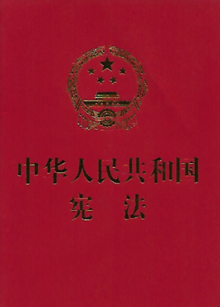
Back دستور جمهورية الصين الشعبية Arabic Constitución de la República Popular China AST Constitució de la República Popular de la Xina Catalan Folkerepublikken Kinas forfatning Danish Verfassung der Volksrepublik China German Σύνταγμα της Λαϊκής Δημοκρατίας της Κίνας Greek Constitución de la República Popular China Spanish Hiina Rahvavabariigi põhiseadus Estonian قانون اساسی جمهوری خلق چین Persian Constitution de la république populaire de Chine de 1982 French
| Constitution of the People's Republic of China | |
|---|---|
 Cover of the current constitution | |
| Overview | |
| Original title | 中华人民共和国宪法 |
| Jurisdiction | China |
| Ratified | December 4, 1982 |
| Date effective | December 4, 1982 |
| System | Unitary Marxist-Leninist one-party socialist republic |
| Government structure | |
| Branches | Six (Legislative, Executive, Military, Supervisory, Judicial, Procuratorial) |
| Head of state | President[a] |
| Chambers | Unicameral (National People's Congress)[b] |
| Executive | State Council headed by the Premier of the State Council |
| Judiciary | Supreme People's Court Supreme People's Procuratorate |
| Federalism | No - Decentralization within a Unitary State (special administrative regions) |
| Electoral college | Yes – the National People's Congress, which elects all other state authorities, is itself elected by two layers of Indirect election: County and Township People's Congresses elect the members of Provincial People's Congresses, who in turn elect the members of the National People's Congress. |
| History | |
| First legislature | September 21, 1949 (Chinese People's Political Consultative Conference) September 27, 1954 (National People's Congress) |
| First executive | September 27, 1954 (1st National People's Congress) October 1, 1949 (Central People's Government) |
| First court | October 22, 1949 |
| Amendments | 5 |
| Last amended | 11 March 2018 |
| Location | Beijing |
| Commissioned by | 11th Communist Party Central Committee |
| Supersedes | 1978 Constitution of the People's Republic of China |
| Full text | |
| Footnote | |
| |
| Constitution of China | |||||||
|---|---|---|---|---|---|---|---|
| Simplified Chinese | 中华人民共和国宪法 | ||||||
| Traditional Chinese | 中華人民共和國憲法 | ||||||
| |||||||
 |
|---|
|
|
The Constitution of the People's Republic of China is the supreme law of the People's Republic of China. It was adopted by the 5th National People's Congress on December 4, 1982, with five subsequent revisions. It is the fourth constitution in PRC history, superseding the 1954 constitution, the 1975 constitution, and the 1978 constitution.[1]
- ^ Diamant, Neil J. (2022). Useful Bullshit: Constitutions in Chinese Politics and Society. Cornell University Press. ISBN 978-1-5017-6129-4. Archived from the original on July 27, 2024. Retrieved February 2, 2022.